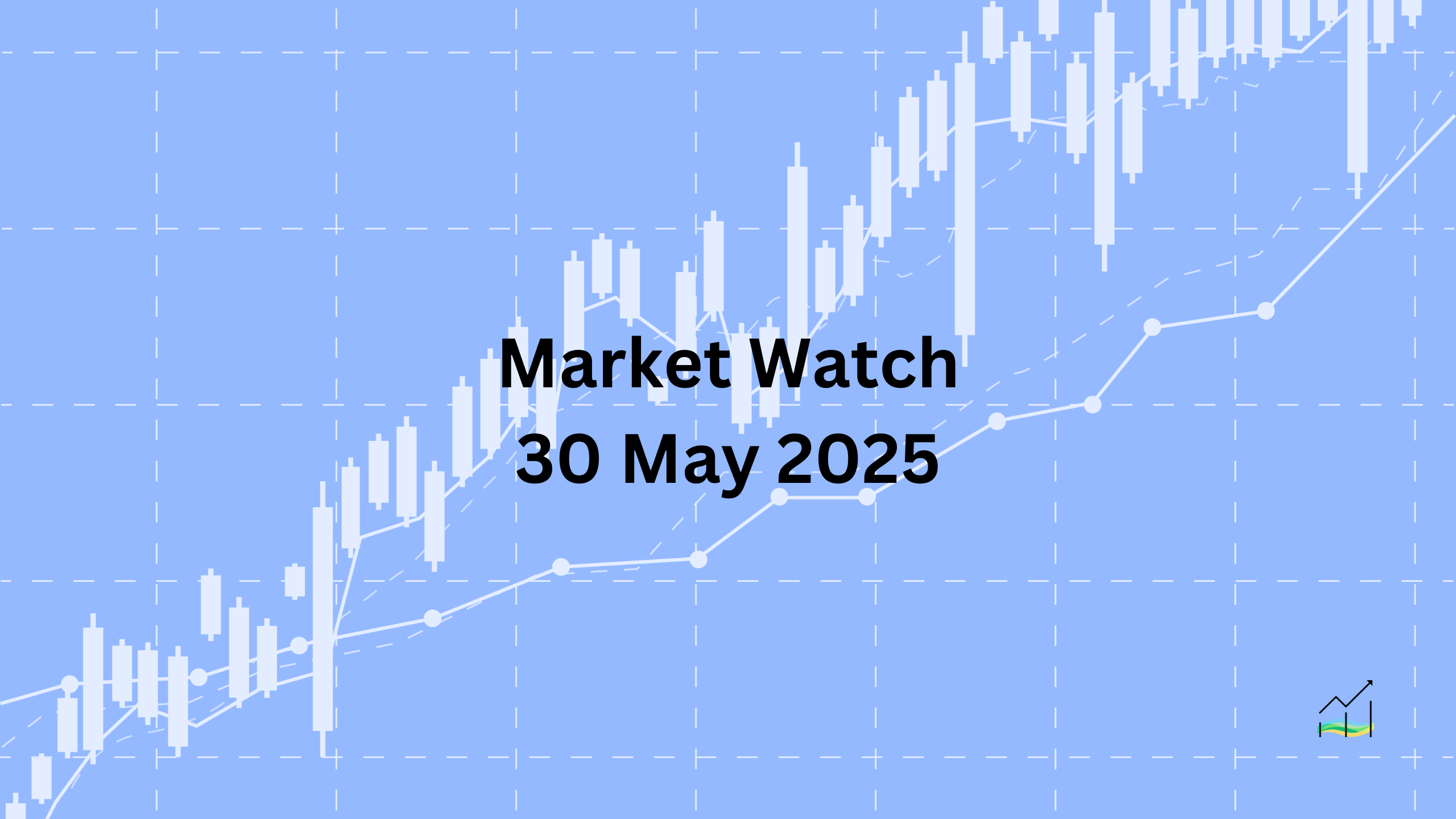30/05/2025 Market Watch

US-China Tensions Resurface & Yields Shift
Key Takeaways:
- US tariffs are back in effect, though the legal process remains unresolved.
- US-China trade talks have stalled, as confirmed by Treasury Secretary Bessent.
- The dollar is stronger across G10 currencies this week, except for the yen and Canadian dollar.
- Japanese long-term yields fell for the first time in weeks, with significant drops in the 30- and 40-year bonds.
- Equity markets are mixed, with Asia mostly lower and Europe slightly higher.
- Gold struggles to stay above $2300, while oil prices remain firm.
The financial markets are ending the month under the shadow of renewed US tariffs and a confirmed breakdown in US-China trade negotiations. While the reinstated tariffs are now in play, the legal dispute continues, keeping geopolitical risks on the table. Treasury Secretary Bessent’s admission that talks with China have stalled only reinforces the market’s risk-off sentiment. This backdrop has revived demand for the US dollar, which is now broadly stronger against the G10 currencies, with the yen and Canadian dollar being the only holdouts.
Japan, meanwhile, saw a notable reversal in its long-term yields. The 30-year government bond yield recorded its first weekly drop in five weeks, while the 40-year yield posted its first decline in eight weeks. A firmer Tokyo CPI may have supported the yen, keeping it relatively resilient despite the broader dollar strength.
Global equity markets are showing mixed signals. Asia mostly closed lower, with Australia and New Zealand as exceptions. European shares are modestly higher, recovering some ground after earlier losses. US futures are slightly in the red, reflecting investor caution. Bond markets remain steady, with minor upticks in both US and European benchmark yields.
Gold is failing to hold ground above the $2300 level, despite a brief recovery, and is set to close the week nearly 2% lower. However, it remains up slightly for the month, marking its fifth consecutive monthly gain. Oil prices continue to edge higher, with July WTI hovering near session highs, showing strength compared to last month’s close.
United States of America
Overview
The US dollar showed weakness in the previous session, but follow-through selling has been limited. After briefly touching a seven-day high near a key downtrend line, the Dollar Index sharply reversed and closed below the prior day’s low. Although it has since recovered modestly, price action suggests a cautious outlook heading into key economic data. Markets are focused on the upcoming April PCE deflator, the Federal Reserve's preferred inflation measure, though it rarely delivers surprises due to its consistent alignment with CPI and PPI trends.
The headline and core PCE figures are expected to show slight year-over-year declines, pointing to softening inflation momentum. Personal consumption growth is also forecast to decelerate notably, suggesting potential headwinds to domestic demand. Meanwhile, the goods trade deficit remains wide despite expectations for a sharp narrowing, and wholesale inventories are likely to show another modest gain.
Sentiment data may receive an upward revision as more optimistic responses post-US-China cooling-off announcements are factored into the University of Michigan’s final May reading. However, attention will soon shift to the critical May employment report. Labour market strength has moderated this year, with nonfarm payrolls growth trailing last year’s pace. A print close to expectations could reinforce the narrative of a gradually slowing economy.
Economic Drivers
- The dollar’s movement remains sensitive to Fed policy signals and inflation developments.
- April PCE data is expected to confirm a gradual decline in inflation pressures.
- Personal consumption growth is likely slowing, hinting at reduced domestic demand.
- The goods trade deficit remains elevated, despite an anticipated narrowing.
- A potential upward revision to consumer sentiment may reflect easing US-China tensions.
- Labour market data next week is expected to provide key direction for monetary policy expectations.
Data and Events
- 30 May 2025: Core PCE Price Index.
- 30 May 2025: Revised UoM Consumer Sentiment.
Price Action
- The Dollar Index reversed sharply from a seven-day high near 100.50 and closed below 99.40.
- Minor rebound seen to 99.60; short-term resistance lies around 99.80–100.00.
- A potential key downside reversal pattern has formed, indicating possible near-term weakness.
Key Points:
- Dollar Index showed bearish reversal but has partially recovered.
- Focus is on PCE inflation and personal consumption trends.
- Trade deficit remains wide; inventories likely rose again.
- Sentiment may improve slightly due to easing geopolitical risks.
- May payrolls data next week could shape the near-term US economic outlook.
Australia
Overview
The Australian dollar briefly strengthened as the US dollar pulled back, finding support near the $0.6400 level and climbing to $0.6460. This move aligns with a partial retracement of its recent losses, though the currency remains confined within a familiar range. Despite this temporary bounce, significant resistance lies around the $0.6500 level, which the market has repeatedly failed to clear throughout May.
Economic data released today fell short of expectations. Building approvals in April declined by 5.7%, sharply missing forecasts for a 3% increase. Retail sales also underperformed, slipping by 0.1% instead of the anticipated 0.3% rise. However, public sector credit provided a slight positive surprise, rising by 0.7% against a 0.5% forecast. In response to the weaker data, market pricing for a potential July rate cut by the Reserve Bank of Australia increased, with odds rising to 67% from around 60% previously.
Looking ahead, markets are focused on next week’s Q1 GDP release. The consensus expectation is for a 0.5% quarterly expansion, which would offer insight into the broader economic trajectory and influence future policy expectations.
Economic Drivers
- The Australian dollar’s recent lift was supported by US dollar weakness.
- Building approvals and retail sales both fell short of forecasts, pointing to weaker domestic demand.
- Public sector credit outperformed expectations, offering a minor offset to the overall soft data.
- Market odds for a July rate cut by the RBA increased following today’s economic releases.
- Anticipation builds for next week’s Q1 GDP figures to gauge economic resilience.
Data and Events
- 30 May 2025: AUD Retail Sales.
Price Action
- AUD/USD rebounded from near $0.6400 to reach $0.6460.
- This aligns with the 38.2% retracement of the recent downtrend from $0.6535 to $0.6400.
- The pair remains within a tight trading range between $0.6410 and $0.6455.
- Key resistance is around $0.6470 (50% retracement), with $0.6500 acting as a strong cap in recent weeks.
Key Points:
- AUD rebounded but remains within a defined range.
- April data disappointed across building approvals and retail sales.
- Odds of an RBA rate cut in July rose to 67%.
- Q1 GDP due next week is the next key event.
Canada
Overview
The Canadian dollar is trading within a narrow band as markets await the Q1 GDP release. The US dollar briefly tested higher levels but failed to sustain momentum, stalling near a key retracement level and the 20-day moving average. While short-term movements remain muted, upcoming economic data and next week’s Bank of Canada (BoC) meeting are likely to influence the currency’s direction.
Canada’s economy is expected to have grown modestly in Q1, but forecasts vary widely. While monthly GDP prints suggest some positive momentum, economists remain cautious. The median expectation points to a 1.7% annualised expansion, a slowdown from the 2.6% pace in Q4 2024. However, other projections suggest a possible contraction of around 0.6%, with expectations for Q3 growth also subdued.
Inflation remains a critical factor. Last week’s higher underlying CPI figures prompted a sharp reassessment of BoC rate expectations. The likelihood of a rate cut at next week’s meeting has dropped from nearly 70% to 25%. As a result, the central bank’s guidance and today’s GDP data will be closely watched by investors for policy signals.
Economic Drivers
- Canada’s Q1 growth outlook is mixed, with forecasts ranging from moderate expansion to mild contraction.
- Monthly GDP data has been underwhelming, contributing to pessimism around quarterly performance.
- Inflation pressures remain elevated, influencing market expectations for monetary policy.
- Market participants have scaled back expectations for a BoC rate cut following stronger-than-expected CPI data.
- The BoC’s decision next week will likely be influenced by today’s GDP figures and inflation dynamics.
Data and Events
- 30 May 2025: GDP.
Price Action
- USD/CAD traded on both sides of Wednesday’s range but closed within it, neutralising near-term signals.
- The upside move stalled just past the 50% retracement from the May 12 high (CAD1.4015) to recent lows.
- Resistance held near CAD1.3870 (20-day moving average); key level above is CAD1.3900.
- Current consolidation remains within CAD1.3800 to CAD1.3830.
Key Points:
- Canadian GDP data is pivotal for near-term direction.
- Q1 growth outlook is uncertain, with risks skewed to the downside.
- Rate cut odds have fallen sharply due to stronger CPI.
- BoC policy decision next week will be closely scrutinised.
China
Overview
The offshore yuan saw increased volatility as the US dollar briefly climbed above the 20-day moving average before reversing lower to a fresh session low. Despite the sharp intraday move, the pair ended the session within Wednesday’s trading range, and it currently hovers near CNH7.20. This pullback reflects cautious positioning ahead of key domestic data and policy signals.
In an unexpected shift, the People’s Bank of China (PBOC) set the daily dollar fixing lower after raising it for three consecutive sessions. This move suggests a desire to manage currency expectations without allowing excessive depreciation. Meanwhile, market focus is on China’s upcoming May PMI data, with both manufacturing and services figures expected to rise modestly.
However, any marginal improvement in PMIs is unlikely to meaningfully ease concerns over the country's growth trajectory. Policymakers remain under pressure as doubts persist about China’s ability to meet its 5% GDP target for the year, especially amid weak private demand and ongoing structural challenges. As such, any improvement in data will need to be sustained and supported by broader policy coordination.
Economic Drivers
- The PBOC signalled moderation by setting a lower USD/CNY fixing after several sessions of strength.
- Slight uptick expected in May PMI data, though not enough to alleviate structural growth concerns.
- Persistent doubts remain over China’s ability to achieve its 5% GDP growth target.
- Economic headwinds include weak domestic consumption and lack of business confidence.
Data and Events
- 31 May 2025: Manufacturing & Non-Manufacturing PMI.
Price Action
- USD/CNH briefly breached the 20-day moving average near CNH7.2060 before reversing lower.
- The pair reached a new session low around CNH7.1825 before settling back near CNH7.20.
- Despite intraday swings, price remained within Wednesday’s trading range.
Key Points:
- PBOC shifted tone by lowering the daily fix after three days of increases.
- May PMI data due tomorrow is expected to show only slight improvement.
- Growth target concerns remain unresolved amid structural challenges.
- Yuan volatility has increased but remains within recent technical boundaries.
Europe
Overview
The euro showed signs of strength following a sharp rebound from an eight-day low. After dipping to $1.1210, it surged to $1.1385 and managed a daily close above the previous session's high. Although it edged closer to the $1.1400 mark early today, renewed selling pressure pulled it back toward $1.1320. This recovery has raised short-term optimism, but macroeconomic fundamentals remain central to market sentiment.
Recent inflation data from the bloc suggests that price pressures are continuing to ease. France’s May CPI saw a notable decline, with the EU-harmonised annual rate falling by 0.6%. Spain and Italy both reported declines to 1.9%, while Germany’s state-level data pointed to stickier inflation, with the national figure expected to remain around 2.2%. The full eurozone inflation report is scheduled for next week and will be critical for the European Central Bank’s policy path.
Markets are closely watching the ECB’s upcoming meeting on June 5. A 25 basis point rate cut is widely expected, bringing the deposit rate down to 2.0%. However, beyond that, the central bank is expected to pause. The swaps market currently prices in only one additional rate cut in the second half of the year, indicating that the ECB may adopt a more cautious stance going forward.
Economic Drivers
- Inflation data from major eurozone economies points to further softening in consumer prices.
- France, Spain, and Italy all reported declines in May CPI, reflecting easing price pressures.
- Germany’s CPI appears more resilient, with the national reading expected to hold near 2.2%.
- The ECB is expected to cut rates by 25 basis points next week but may signal a pause afterward.
- Market pricing reflects confidence in only one additional rate cut in the second half of 2025.
Data and Events
- 30 May 2025: German Retail Sales.
- 30 May 2025: German Prelim CPI.
- 30 May 2025: Spanish Flash CPI.
- 30 May 2025: Italian Prelim CPI.
Price Action
- EUR/USD rebounded from $1.1210 to $1.1385, closing above the previous day’s high.
- Briefly approached $1.1400 before retracing to around $1.1320 on renewed selling.
- Potential key upside reversal pattern in place, but upside momentum faces resistance near $1.1400.
Key Points:
- Euro rebounded strongly but faced resistance near $1.1400.
- May CPI data shows continued disinflation across much of the eurozone.
- ECB expected to deliver a 25 bp rate cut next week, followed by a potential pause.
- Markets price in only one more cut for H2 2025.
Japan
Overview
The Japanese yen experienced significant volatility following the US trade court ruling, with the dollar initially surging toward JPY146.30 before reversing sharply. The pair dropped to JPY143.45 today after testing JPY144 during the previous session. This move has brought the dollar closer to this month’s low near JPY142.10, reflecting shifting sentiment amid domestic economic updates and global developments.
A series of Japanese macroeconomic indicators were released, offering a mixed snapshot of the economy. The labour market remains stable, with unemployment at 2.5% and the job-to-applicant ratio unchanged at 1.26. Industrial production contracted by 0.9% in April, which was better than expected. Retail sales rebounded by 0.5% following a sharp decline in March, suggesting a modest recovery in consumption, though growth remains slower than in the same period last year.
Tokyo’s May CPI data showed inflation pressures remain elevated. The headline figure held steady at 3.4%, while core inflation (excluding fresh food) rose to 3.6%. The measure excluding both fresh food and energy climbed to 3.3%, its highest since late 2023. Despite persistent inflation, the market has trimmed expectations for policy tightening. Swaps now price in around 17 basis points of hikes this year, down from 30 basis points in March.
Economic Drivers
- The US trade court ruling triggered significant FX volatility against the yen.
- Labour market conditions remain steady, showing no signs of stress.
- Industrial output contracted less than forecast, offering slight relief.
- Retail sales posted a modest rebound in April, though year-to-date growth is slower than 2024 levels.
- Tokyo CPI data confirms inflation remains high, especially in core categories.
- Market expectations for further BoJ tightening have moderated since March.
Data and Events
- 30 May 2025: Tokyo Core CPI.
- 30 May 2025: Unemployment Rate.
- 30 May 2025: Prelim Industrial Production.
- 30 May 2025: Retail Sales.
- 30 May 2025: Housing Starts.
Price Action
- USD/JPY spiked to near JPY146.30 before dropping to JPY143.45 today.
- This move aligned with the 61.8% retracement of the drop from the May 12 high (JPY148.65).
- Selling pressure increased after the spike, driving the pair toward this month’s low near JPY142.10.
- Momentum has shifted to the downside after the post-ruling spike.
Key Points:
- Yen strengthened after initial spike on US trade ruling.
- Labour market remains stable; industrial output contracted less than expected.
- Retail sales improved modestly; inflation remains sticky.
- Market pricing for BoJ hikes has softened to 17 bp for the year.
© 2025 SKONE Enterprise (003319453-V). All rights reserved.
The content on this site is for informational purposes only and does not constitute financial advice.


